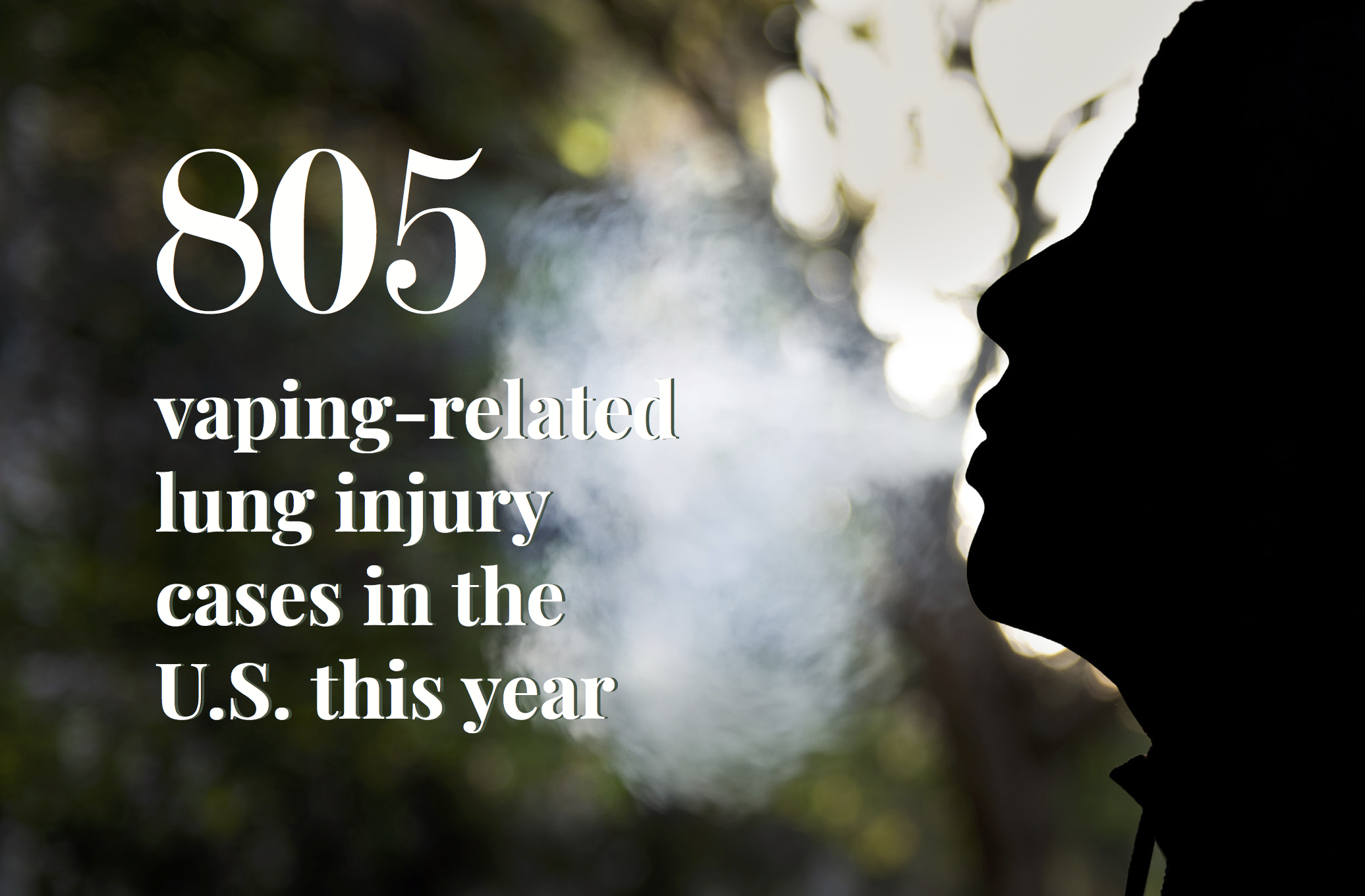Experts, public officials become increasingly concerned about effects of vaping

The Los Angeles County Department of Public Health sent out a press release warning residents to stop using all electronic smoking devices. (Kanishka Mehra and Kristie-Valerie Hoang/Daily Bruin staff)

By Sameera Pant
Sept. 30, 2019 1:08 a.m.
Experts are unsure about what is causing the surge in vaping-related lung injuries.
A post published Friday stated that 805 vaping-related lung injury cases have been reported spanning 46 states and one U.S. territory, according to the Centers for Disease Control and Prevention. With the rise in these cases comes a rise in discussion about the consumption and regulation of the devices that caused them.
The Los Angeles County Department of Public Health urged LA residents to stop using all e-smoking devices in a Thursday press release. According to the LADPH, patients with lung injuries experienced coughing, nausea and fatigue, among other symptoms, a few days to a few weeks after e-cigarette use.
Medical professionals are still uncertain on how to best treat these cases, however.
Steven Chang, a pulmonary disease specialist and co-director of the Medical Intensive Care Unit at the Ronald Reagan UCLA Medical Center, said he believes problems with attempts to treat these cases stem from a lack of research on vape products before they became available on the market.
“This is a really recent phenomenon,” Chang said. “The CDC and state health departments are still trying to sort it out. There’s still really isn’t an answer about a specific disease process – all we know is that it causes a non-specific lung injury.”
Doctors are uncertain whether electronic cigarettes, commonly referred to as vapes, are more detrimental than their traditional counterparts.
However, there is indirect evidence that tobacco-based cigarettes cause more harm than electronic ones, said Holly Middlekauff, a cardiologist at the Ronald Reagan UCLA Medical Center whose research focuses on the effect of e-cigarette use on the heart.
“(There are) 70 known carcinogens and 7,000 other constituents in tobacco cigarette smoke,” she said. “The number of carcinogens and constituents are far fewer, if present at all, in electronic cigarette emissions.”
Smoking tobacco cigarettes involves the combustion of organic material, a process that generates these carcinogens, alongside other toxic products. Conversely, e-cigarettes do not involve combustion as they’re designed to heat rather than burn, Middlekauff said.
Typically, e-cigarettes contain flavoring and solvents like propylene glycol and vegetable glycerin, Middlekauff said. Commonly referred to as PG and VG, respectively, these combine with flavor and sometimes nicotine to create the base for the liquid in e-cigarette cartridges, or “e-juice.”
Although it is not obligatory for e-cigarettes to contain nicotine, the addictive stimulant is not the overarching problem, she added.
“The issues with electronic cigarettes is, of course, they’re not regulated so all sorts of contaminants can go into them,” Middlekauff said. “The buyer does not know what they’re getting. … Separate from the liquid (in the cartridges), the device itself can be dangerous.”
For example, bits of metal have been found in the vapor produced by e-smoking devices. The devices can even explode due to battery malfunctions, Middlekauff said.
Middlekauff said people who use these products often have higher rates of heart rate variability than those who do not.
“The same general pattern of heart rate variability that we found in our chronic electronic cigarette users is the same pattern that has been seen in patients with known heart disease,” Middlekauff said.
This makes users more likely to experience either a heart attack or cardiac arrest, Middlekauff said.
E-cigarette use may also negatively impact the ability of blood vessels to expand, Middlekauff added. This is another indicator for heart attack risk, as heart attacks are caused by obstructions to blood flow.
Middlekauff said that cannabis-based vape products should be avoided, as there is evidence that people suffering lung injuries have been more likely to use cannabis-based products rather than the nicotine ones.
Of patients with vaping-related injuries, 77% reported using cannabis-based products with or without nicotine-containing products, according to a Friday press release from the CDC.
“It may or may not be the cannabis,” Middlekauff said. “In fact, they think it may be a contaminant in that, but we just don’t know what’s in these products. … We’re inhaling these substances into a very fragile and delicate tissue, our lung tissue, which is very vulnerable to even small amounts of toxins.”
Patrick Ersig, the chief executive officer of Ocean Cannabis Company, a Long Beach-based cannabis goods company, said he feels the current outbreak is not due to the products themselves but to knockoff products. As legal vapes are tested for heavy metals and pesticides, they tend to be more expensive than those found on the black market, he added.
“The (unregulated vape cartridges) are not being tested, and they are being (made) with things that can harm people,” Ersig said. “The solution to the problem is to really crack down on the illicit market, which is really causing these problems.”
Ersig said the illegal vape cartridges had been tested positive for vitamin E acetate, a chemical that has been linked to the vaping cases, citing a Washington Post article published Friday.
“Our take is (that we) really want the public to purchase or consume (cartridges) from the legal market,” Ersig said.
Ersig added that if states ban the legal market for vapes as a way to control the situation, it would only give further power to the illegal market.
“I think it will actually increase the problems that we’re seeing,” he said. “But I think if you decide to crack down on the illegal market and the illicit market, I think that will see these problems cease. … Consumers will still be comfortable using the product. People have been using vapes in California for close to a dozen years now.”
Furthermore, California has stringent testing for legally marketed vapes, Ersig said. A legal dispensary ensures that whatever a consumer inhales has been tested for pesticides and heavy metals, he added.
Middlekauff said she believes that vape culture will change despite its prevalence among the younger generation.
“I think, initially, young people started using electronic cigarettes because they thought it harmless, you know?” Middlekauff said. “How can something that tastes like Skittles be bad for you?”
Current developments have undoubtedly altered that perception, she said.
“Electronic cigarettes can be very bad for you. They can be lethal, and you don’t have to wait 20 or 30 years to find that out,” Middlekauff said.
Chang said that current symptoms point to a condition similar to pneumonia. Currently, patients are only receiving supportive care as medical practitioners learn more about the condition, he added.
“Some people have tried steroids with success, but I don’t know that anyone can say for sure that should be used yet,” he said.
Chang added that, at the moment, doctors have been treating the injuries the way they would treat any other acute lung injury, like smoke-induced injuries from a fire.
Whether it is a contaminant in vapes causing them to be lethal or the devices themselves, Middlekauff urges people not to roll the dice.
“These are serious things,” she said “What happens when you get to your parents’ age (is) happening to young people now.”


